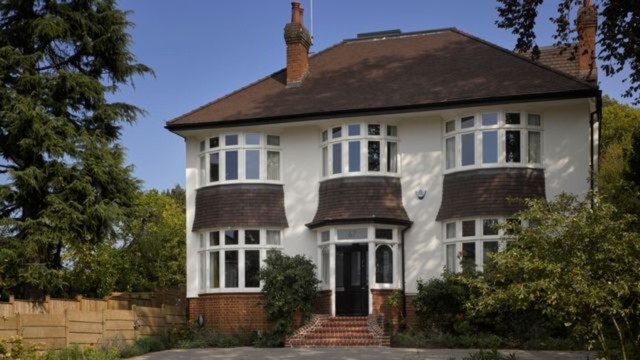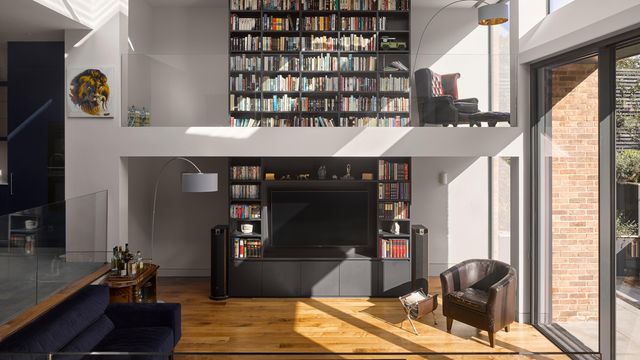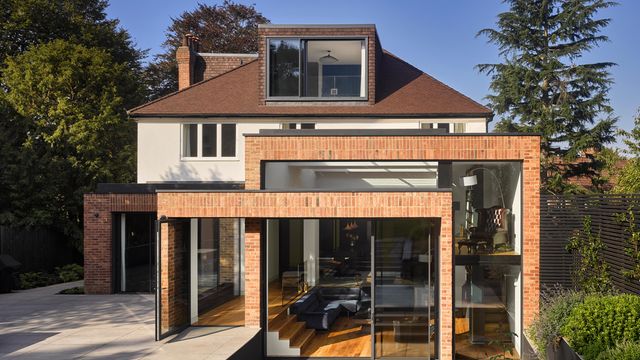One of the themes I believe I have encountered in the course of my architecture-spotting is the one I’ve been calling The Triumph of Modernism Indoors. These photos, taken from a piece about a house conversion that’s just been done in Highgate, illustrate that this may not be quite the right distinction.
Here’s a piece of classic ancientist victory, in the form of a deceptively normal looking house in Highgate. It’s had a total makeover, but you wouldn’t know this just looking at it from the street outside:
Indoors, however, modernism reigns supreme:
However, modernism has also made its presence felt out of doors, round the back, in the garden, which passers-by do not see:
The continuing dominance (not total victory by any means) of ancientism has been in “public” rather that “outdoors”, and the triumph of modernism has been in “private” rather than merely indoors. The point being that the outdoor triumphs of modernism are tending particularly to happen also in the private bits of outdoors.
What’s going on here is that the “private citizen” wants modernism in those bits of his place that he totally controls, because modernism makes more sense, and is cheaper and quicker to do. But, “public citizens” don’t care for the way modernism looks, especially if it replaces ancientism in the public realm. So the public bits of a building, if they are now ancientism, cannot be smashed to bits and replaced by modernism, if preserved ancientism is an option, as it was for this ancientist Highgate home. But if the private citizen himself positively likes the public appearance of modernism, he can do modernism outdoors also, provided he only does it in the private bits of outdoors, the bits that he experiences but which passers-by do not.
Everything will hinge on whether an ancientist house with a modernist extension out the back in the garden will sell for the same silly money as a house with no modernist stuff outdoors in the garden.
I’m guessing it will so sell, provide only that the extension does the job without silly things like a leaking roof.
I am zeroing in on another over-arching fact about “private householders”. They’d like a house that looks publicly nice, but when economic push comes to economic shove, what matters is whether their newly acquired house works properly, without having to be expensively mended. For all their aesthetic tastes. their aesthetic tastes don’t actually matter, or rather, don’t matter enough to have real world consequences. What does matter is that their machine for living in should tick over correctly, the way a properly functioning machine should.
This increasingly “private” blogging that I’ve been doing for about the last fifteen years is really starting to achieve things for me.




Have you noticed in the article you link to that the left hand side of the ancientist frontage is fake being built at the same time as the modernist rear extension?
Have you also noticed that americans, who tend to line in houses with modernist exteriors tend to favour fake ancientist interiors much more than we do? Google image search american home interiors to see what i mean
Your [very interesting] thoughts on the subject – private vs public, modernism vs “ancientism” are based on assumption that the choice is completely free.
Don’t know how it is in Kent, but here, in the States there exist such an abhorrent thing as HOA (https://en.wikipedia.org/wiki/Neighborhood_association). HOA dictate to a home owner how his/her house should look, including facades, height of fence/gates, landscaping, etc – from paint color to style to materials. If this Kent homeowner experienced anything like that, I feel pretty certain he/she was not as free in their choices as you assume.
And the design….how should I put it…will not be to everyone’s liking when it’ll be time to sell it. The amount of space taken by paper books. The demolition of garden extensions / conservatories. The low-ceiling kitchen. The cold sanitary bathroom (mentally remove the vase with flowers – what’s left? ).The ‘sunken” rooms below yard level. The “gallery” above that sunken room – by the way, how can you get there? I went to the architects’ site to see if they show more photos to explain that – but no. There is no stair, no ladder, and the level of story (floor) is in-between.
Tatyana, I think if you look carefully through the right hand window of the rear elevation there is a staircase behind the bookshelves.
I can say I would quite like to do that to my house. Provided, as you say, the roof does not leak.